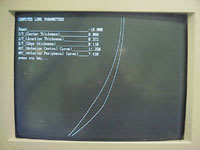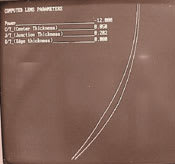ULTRA-THIN RGPS
Custom-designed Ultra-thin RGP Lenses
Use new technology to design and manufacture thinner, stronger and more comfortable RGP lenses.
By Leonard R.
Achiron, OD
May 2001
Ultra-thin rigid gas permeable lens designs reduce overall lens mass and thickness, both of which affect lens-to-corneal alignment, oxygen transmissibility (Dk/L) and lid awareness. Improved structural integrity of rigid gas permeable materials, lens design software and precision computer numeric control (CNC) lathes have given practitioners the capability to design ultra-thin RGP lenses (center thickness<0.05mm).
Lens Design
In 1979, Syntex developed the Polycon II design which became the gold standard for thin RGP lens designs in high minus powers. The Polycon II was a tricurve design with a standard center thickness of 0.08mm and an edge thickness of 0.10mm. (Figure 1).
Aspheric contact lens designs use complex polynomial algorithims. Advances in computer technology have enabled lens designers to program software that rapidly calculates equation variables like base curve, peripheral aspheric curves, minimum center thickness, junction thickness and edge thickness. Two examples of new aspheric design programs are the SmartCurve Technology by Art Optical and Comfort Zone by ABBA Optical.

Figure 1. Polycon II Tricurve RGP design. Note the junction thickness (0.40mm) in this "thin" tricurve design.
Lens Materials
Recent advances in polymer chemistry by leading contact lens manufacturers have dramatically improved the consistent fabrication of ultra-thin RGP designs.
To cut RGP lenses into ultra-thin profiles without excessive breakage, materials needed to be more stable and flexible. This was difficult with silicone acrylate lenses. Silicone provides better oxygen permeability of RGP materials than polymethylmethacrylate (PMMA), but has poor wetting characteristics and a low modulus or hardness factor. To solve this problem, contact lens manufacturers attempted to decrease the amount of silicone while incorporating a new copolymer, fluorine, into the formulas of silicone acrylate polymers.
Reducing the amount of silicone made the RGP material less oxygen permeable like PMMA and more brittle. However, through advances in polymer chemistry research, contact lens manufacturers were eventually able to reduce the concentration of silicone and increase the fluorine concentration to produce a moderate Dk material with good flexural resistance and hardness.
Fluoroperm 30 and Boston RXD (1988) were among the first F/S/A gas permeable materials to have the appropriate stability, modulus and flexibility to withstand the rigors of machining and polishing. Having perfected the mixture of silicone, fluorine and methylmethacrylate, the next step was to optimize the polymerization reaction and/or strengthen the polymer chain structure (cross-linking).
Paragon Vision Sciences concentrated their research on the polymerization process. They developed a hyperpurified delivery system (HDS) to eliminate the waste products (residuals) generated as a byproduct of polymerization. This produced a uniform, oxygen-efficient silicone copolymer. Paragon collaborated with National Aeronautics Space Association (NASA) while developing their polymerization process. NASA needed Paragon's expertise in polymer chemistry to develop rigid gas permeable atmospheric probes for use on space shuttle missions. The results led Paragon to its HDS for purifying "good" versus "bad" silicone polymers. Paragon Thin is an example of their latest HDS material.
Polymer Technology focused their research efforts on strengthening the cross-linking chains. Traditional cross-linkers use a PMMA backbone, contain no silicone and are relatively stiff. Polymer developed a flexible cross-linking architecture, which they termed Aercor. This backbone contained an alternating silicon-oxygen unit, adding greater spacing between the molecules and enhancing flexibility. The backbone also generated equivalent levels of oxygen permeability (Dk=20) at lower silicone concentrations (five to seven percent) in the F/S/A copolymer. Boston ES is an example of Polymer Technology's new cross-linking architecture.

Figure 2. Aspheric peripheral curves. Computer-generated view of a thin aspheric RGP lens design with a center thickness of 0.10 mm.
Lens Manufacturing
As little as 10 years ago, contact lenses were made with manual and semi-automatic lathes driven by hand. The surface resolution produced by these machines depended upon the skill of the lathe operator. Polishing time averaged between one and two minutes per surface cut on the lathe. For a standard tri-curve design, the base curve was polished for a minimum of three to six minutes with an additional one or two minutes to blend the junctions together. That was a total of four to eight minutes polishing time just for the back surface. The front curves also were polished in two or three steps after the edges were shaped and rolled by hand.
Heat is one of the biggest nemeses for RGP manufacturing, causing reduced optical clarity, poor surface wettability and increased brittleness. The longer a lens was polished, the greater the heat-generating friction. Finished RGP lenses were therefore made thicker to prevent fracturing during the manufacturing process.
Lathe manufacturers such as DAC International and Precitec realized the need for ultra-precision lathes for producing contact and intraocular lenses. They engineered lathes with air bearing spindles and rotary tables using servomotors with 10 nanometer resolution feedback. These new lathes feature a four- axis oscillating tool capable of producing spherical, toric or aspherical surfaces in any meridian. The resolution of the new DAC DLL Series III/4X OTT lathe is 0.027 microns. The lathe also produces the edge of the lens, reducing polishing time to approximately 14 seconds. The minimal polishing time with these high-precision CNC lathes combined with the lens design algorithms and high speed Pentium coprocessors creates the capability to produce extremely thin RGP lenses.

Figure 3. Ultra-thin design. Computer-generated view of a custom-designed ultra-thin RGP (0.05 mm CT). Note the difference in junction thickness (0.282mm) as compared to the thin aspheric design (.372mm).
Custom-designed Thin RGP Lenses Rules of Thumb
We employed these basic techniques to design our ultra-thin lenses:
I. Make high minus RGP lenses thinner by reducing the center thickness.
II. Make high plus lenses thinner by reducing the junctional thickness.
III. Make high power plus or minus lenses thinner by starting the lens taper earlier, decreasing the posterior optic zone and anterior bowl diameter.
To demonstrate how lens design programs can be modified to generate ultra-thin designs, we used the "Xpert" Lens Design Program Series by Larry Platt of Platt Contact Lens Service. This lens design program served as a consultant to contact lens laboratories prior to the widespread use of CNC lathes programmed with proprietary design software.
We consulted the program to prescribe a 12.00D spherical lens, Boston EO material (Dk 82), base curve of 45.50 diopters and standard lens diameter of 9.0mm. The program identifies a default center thickness of 0.13mm, junctional thickness of 0.38mm, a lens mass of 14.67mg, volume of 12.43mm3 and a Dk/L of 35.90. This early program can calculate only spherical designs; but we can get the idea of how modifying lens parameters can change the outcome of the finished product. We entered a new center thickness of 0.03mm into the Xpert lens design program while keeping the rest of the parameters the same. The following changes occurred: Dk/L=60.92, lens mass and volume decreased to 8.34 and 7.32 respectively and junction thickness is decreased 0.28mm. Originally, we designed this high minus lens with a high Dk material to bring greater oxygen levels to the cornea. We were not satisfied with a 66 percent reduction in oxygen transmission using a laboratory default center thickness setting of 0.13mm. By modifying the center thickness setting from 0.13mm to 0.03mm, the Dk/L returned to a moderate Dk/L=61 compared to 36 in the default computer setting. The lens mass also decreased 57 percent from 14.67 to 8.34 with the thinner center thickness and the junction thickness reduced by 26 percent from 0.38mm to 0.28mm (Figure 2).
Incorporating our second rule of thumb, we modified the region between the optic zone and the aspheric peripheral curves by beginning the taper earlier. This thinned the junctional zones by reducing the anterior bowl and posterior optic zone from the default setting of 8.0mm down to approximately 6.0mm, reducing the junction zone thickness from 0.28mm to 0.17mm. Figure 3 shows an ultra-thin design.
Of course, it is impossible to truly achieve uniform lens thickness and maintain the dioptral power on the front surface. Therefore, we use the term uniform thickness solely for descriptive purposes. Also, be aware that many of the proprietary software programs for aspheric RGP lenses that claim uniform thickness maintain a constant edge thickness despite the dioptral power of the lens.
We recommend Paragon Thin or Boston ES material, with a ComfortZone Design (aspheric) for minus lenses. We recommend for low minus powers (1.00D to 3.50D) a center thickness of 0.08mm. For moderate myopia (4.00D to 7.50D), we recommend reducing the center thickness to 0.05mm. In high myopia (>8.00D) we recommend custom designing the POZ taper to begin at approximately 6.0mm and to employ a center thickness of 0.03mm.
In high plus lenses, the center thickness is dictated by the junctional zone thickness. First reduce the junction thickness in a high plus lens to reduce the center thickness. In high plus powers, taper the POZ and bowl diameter early to achieve a significant difference in the lens thickness.
For example, we consulted the Xpert Lens Design program for a +12.00D spherical lens, Boston ES material, K readings of 42.00 diopters and lens diameter of 9.0mm. Default parameters included Dk/L= 10.17, posterior optic zone and bowl diameter 7.99mm, center thickness 0.44mm and junction thickness 0.17mm. Modifying the junction thickness from 0.17mm to 0.08mm reduced the center thickness to 0.36mm. It was only after we decreased the POZ and bowl diameter to 6.0mm that the program responded by adjusting the lens thickness from 0.44mm to 0.22mm, a 50 percent reduction. The overall lens mass also changed from 19.43 to 6.31, a 66 percent reduction, when we modified the default settings. Furthermore, the potential oxygen transmission (Dk/L) increased 27 percent.
In high plus RGP lenses, an ultra-thin design maintains the optimal lens-corneal base curve without excessive lens mass dragging the lens downward. For modifying high plus lenses we recommend:
- Reduce the junction thickness 0.05-0.10mm, depending on the lens power.
- Decrease the POZ and anterior bowl diameters approximately 1 to 2 mm, depending on pupil size.
These lens modifications will synergistically improve potential oxygen transmissibility. Also consider the specific gravity and index of refraction of the lens material. Fluoroperm 30 (n= 1.47) has a high index of refraction, which produces a more effective ultra-thin design.
Conclusion
Practitioners can custom-design ultra-thin RGP lenses to enhance oxygen transmission (Dk/L) as well as reduce overall lens mass. Default laboratory settings for the CNC lathes are proprietary, and some of the existing lens designs such as Thin-site by Art Optical or Comfort Zone by ABBA Optical are very thin in comparison to the default settings in the Xpert program. In fact, the Thin-site RGP software uses an optic zone of approximately 7.0mm and a center and edge thickness of 0.08mm. Advances in polymer chemistry have developed lens materials such as the Boston ES and Paragon Thin with greater flexure resistance, enhanced oxygen efficiency and improved machinability in ultra-thin parameters. Finally, a partnership with a contact lens laboratory is essential. Designing the lens is only half of the battle.
Dr. Achiron acknowledges Lee Dickerson, president of ABBA Optical, Inc. for his help and expertise in manufacturing ultra-thin RGP lenses.
To receive references via fax, call (800) 239-4684 and request document #71. (Have a fax number ready.)
Dr. Achiron is in private practice in Atlanta, GA, and is Clinical Director of Laser Vision Institute. He is a Diplomate and Interview Chairman of the American Academy of Optometry Primary Care Section and is on the medical staff of Chestatee Regional Hospital in Dahlonega, GA.



